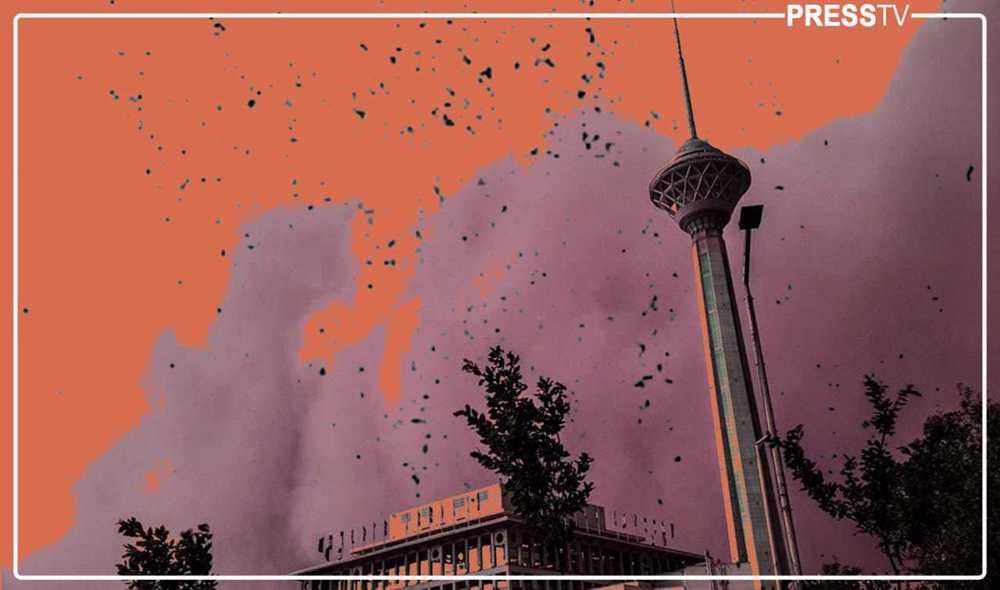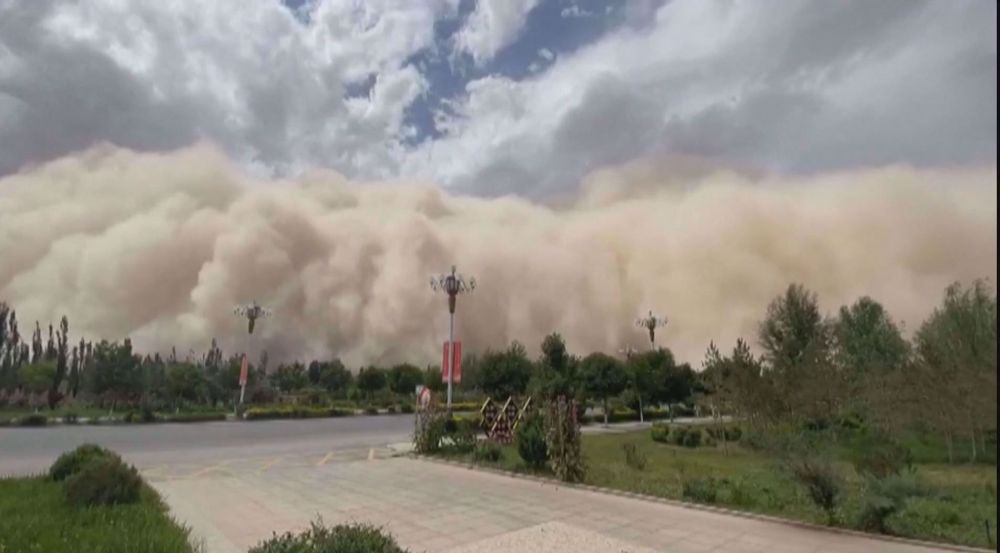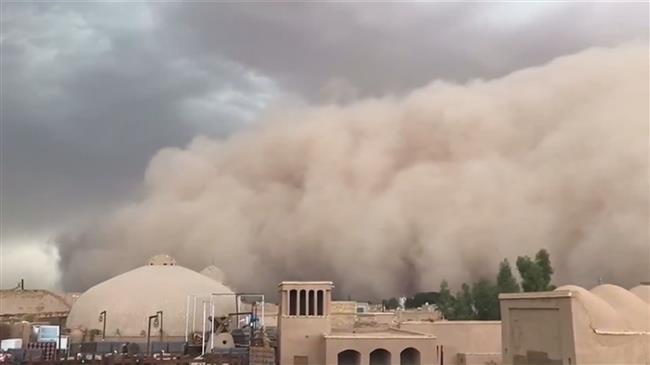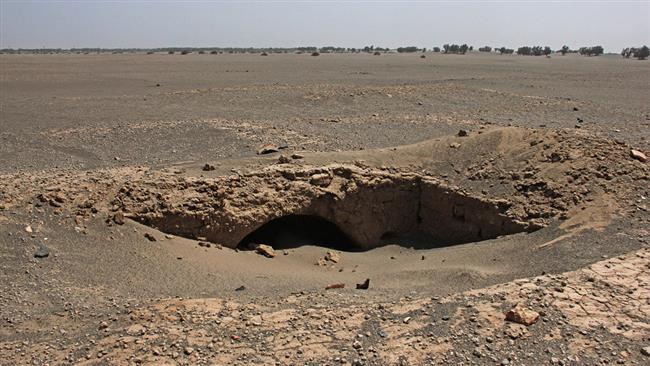Climate apocalypse? Wave of dust storms puts West Asia on edge
By Maryam Qarehgozlou
Since April this year, air pollution levels in Tehran have seen a sharp spike with a thick blanket of noxious smog engulfing the capital city at irregular intervals, impairing visibility and fueling health concerns.
The rapidly deteriorating air quality in the capital city and adjoining provinces has forced the closure of government offices, schools, and universities on at least two occasions in recent months.
More alarmingly, Tehran has earned the dubious distinction of being the most polluted city in the world at least four times since March 21, according to IQAir, the Switzerland-based air quality technology firm.
The problem, however, is not unique to Iran. Dust storms have become a feature of life in the region over the years, filling the skies with a thick and in some cases ominous orange haze for days together.
In recent months, the phenomenon has assumed alarming proportions, especially in neighboring Iraq and Syria, causing loss of life and environmental destruction in the Arab countries.
Officials and experts in Iran say dust storms originating in these countries have slowly but worryingly caught Iran in their grip, with many cities, including Tehran, disappearing into the haze for days.
The environmental scourge has sent many people to hospitals in recent months, while also shutting down educational institutions and bringing air traffic virtually to a grinding halt.
Environmentalists fear if the current condition persists, dust storms will pose greater health hazards, result in more premature deaths and incur huge economic costs for countries in the region.
To avert such a situation, the Iranian government convened a high-level regional meeting today, in a bid to collectively work out a solution to the protracted crisis, according to reports.
Tehran has been spearheading efforts to tackle the growing crisis, with top officials including President Ebrahim Raeisi and Foreign Minister Hossein Amir-Abdollahian mentioning it repeatedly.
What is sand and dust storm?
Sand and dust storms are defined as meteorological hazards that mostly happen in arid and semi-arid regions when strong winds detach large amounts of soil particles from dry lands with no vegetation cover into the atmosphere. The wind then transports those particles thousands of kilometers away.
Ali Darvishi Boloorani, a leading environmentalist and a National Sand and Dust Storm Expert at the Food and Agriculture Organization of the United Nations (FAO) in an interview with the Press TV Website cited some of the sources of this dangerous phenomenon.
“Bare lands with poor topsoil structure such as abandoned farmlands, degraded rangelands, dried marshlands, dried up or shrinking bodies of water like Urmia Lake [in northwestern Iran], dried beds of seasonal rivers and desserts are the main sources of sand and dust storms,” he said.
According to a report by the Asian and Pacific Centre for the Development of Disaster Information Management, the Asia-Pacific region is the world’s second-largest in terms of mineral dust emissions.
The region, the report stated, includes four sandstorm corridors: East and North-East Asia, South and South-West Asia, Central Asia, and the Pacific sub-regions.
Numerous sand and dust storm hotspots are located across these corridors, posing a myriad of threats.
Iran, home to many deserts and semi-deserts, has a range of dust hotspots where sand and dust storms originate. The country is also located downwind and vulnerable to sandstorms traveling across international boundaries.
Main drivers of dust storms
Generally, climate controls sand and dust storms, so any changes in temperature, timing, and distribution of rainfalls, wind regime, and vegetation cover can worsen or mitigate the severity and frequency of sand and dust storms, as per experts.
According to the latest data published by Iran’s Meteorological Organization, the country’s nine-month average rainfall dropped by about 29 percent since the beginning of the current water year starting September 22, 2022, compared to the same period last year.
Moreover, a combination of human-driven changes in land use and land cover such as deforestation, urbanization, and shifts in vegetation patterns, which also cause climatic changes, give rise to extensive wind erosion in dried-up lands and consequently worsen the problem of air pollution.
“Climate change, prolonged drought spells, poor farming practices, overgrazing, overpopulation, and dam construction upstream regardless of the downstream water rights are some of the main drivers of the sand and dust storms in the Tigris and Euphrates basin,” Boloorani said.
Reza Shahbazi, Director of Geohazards, Engineering and Environmental Geology at the Geological Survey of Iran, told the Press TV Website that in addition to the above-mentioned factors, “pressuring and depleting water resources, loss of soil moisture, and weather extremes such as heavy downpours causing floods, and heat waves are also environmental liabilities stirring up sand and dust storms.”
Importantly, he said, dust storms emerged more than two decades ago in Iran parallel with the beginning of drought spells in the country.
Environmental factors coupled with regional instability and Takfiri groups (Daesh et al) ravaging West Asia largely undermined environmental conservation goals, he hastened to add.
Ali Mohammad Tahmasebi, head of the national working group for mitigating sand and dust storms, told the Press TV Website that over and above prolonged drought spells, foreign military convoys in regional countries, and the use of war crafts have resulted in the loss of vegetation cover.
“Regional conflicts and Takfiri groups have contributed to the intensity of such sandstorms,” he said.
Sanctions, too, have played a part by hampering efforts toward procurement or renovation of remote sensing instruments that have a high potential for estimating meteorological variables, Tahmasebi noted.
Millions of hectares of dust storm sources in West Asia
Tahmasebi pointed to about 34.6 million hectares of hotspots across 22 provinces of Iran where sand and dust storms originate, with nearly 270 million hectares of hotspots located outside the country.
“We have studied some 20 countries,” he said. “The primary sources are located in Saudi Arabia with the highest intensity and vastness covering an area of about 90 million hectares, and then in Turkmenistan stretching over more than 60 million hectares followed by Iraq with about 24 million hectares of hotspots.”
Whether dust particles contributing to storms that frequently hit the country come from sources inside or outside Iran's borders is open to debate.
However, experts are of the opinion that arid lands, mainly in the desiccated plains of Iraq and Syria, cover a greater area outside Iran’s border than the hotspots in Iran.
“Iran’s neighboring countries are hit by worse water shortages,” Shahbazi said. “Poor agricultural practices and water management strategies plus regional conflicts are wreaking havoc with environment protection plans in the region.”
He insisted that while Iran’s share of such hotspots is smaller compared to other sources surrounding it in the region, it is not simple to determine how much these dust emitters, inside and outside the country, are responsible for the bulk of the storm that blankets Iranian cities each time.
“Statistics for each dust storm cannot be generalized as each source, domestic or trans-national, might dominate at a specific time of the year and trends might vary at different seasons and in different years,” Shahbazi said.
“What is evident is that we are located in an arid belt and surrounded by arid countries.”
He, however, hastened to add that dust storms blowing into the country from non-domestic sources tend to cover a vaster land area of the country and last longer compared to dust storms that originate from domestic sources with local effects.
“Dust particles coating the country in domestically originated sandstorms are larger in diameter relatively, therefore, pose less significant health risks,” the expert said.
Risks associated with dust storms
Findings of the APDIMS’ Sand and Dust Storms Risk Assessment in Asia and the Pacific show that more than 500 million people in India and more than 80 percent of the entire population of Turkmenistan, Pakistan, Uzbekistan, Tajikistan, and Iran are exposed to medium and high levels of poor air quality due to sand and dust storms.
The impact of sand and dust storms is not limited to health hazards alone, expert studies reveal, but they pose risks to other sectors as well, including agriculture, energy, environment, and aviation.
In its 2021 assessment report, APDIM, the regional institution of the United Nations Economic and Social Commission for Asia and the Pacific (ESCAP), headquartered in Tehran, said dust storms considerably affect the generation of electricity by solar power plants, resulting in flights delay, diversion, and cancellation due to low visibility, and reduce crops yields by increasing farmlands’ salt content.
Deposition of dust on glaciers, the report noted, induces a warming effect that results in greater melting of ice, directly or indirectly impacting agriculture, food security, energy production, and flood regimens.
The report projected that in the 2030s, more extreme drought conditions and water stress in Iran and other countries such as Afghanistan, Australia, and Turkey could increase the risks.
Sand and dust storms also tend to harm the economy, according to a 2019 World Bank report focusing on the Middle East and North Africa region (MENA), which said dust concentration and storms cost more than $150 billion annually and over 2.5 percent of GDP for most countries in the region.
The MENA region, the report stated, incurs an annual $13-billion loss due to the dust storms alone.
Turkey’s dam construction partly at fault
According to Boloorani, an associate professor of environmental remote sensing at the University of Tehran, there are many dust hotspots across West Asia, with the Euphrates and Tigris rivers basins being the primary sources where dust storms originate.
The Euphrates and Tigris is a transboundary basin that covers Iraq, Turkey, Iran, and Syria.
In May, Foreign Minister Abdollahian criticized Turkey's dam construction activities, saying it affects the flow of water into Iran, calling on Ankara to halt such activities.
In response, the Turkish foreign ministry dismissed Iran’s concerns that the country’s dam-building activities had caused droughts in the region, calling them “far from scientific”.
“We have plentiful evidence that suggests that dam construction along with drought and undeveloped agriculture are directly affecting dust storms occurring in the Euphrates and Tigris downstream,” Boloorani said.
“We have investigated nearly 30 thousand satellite images of the whole basin from 2000 to 2022 and identified about 10,000 dust hotspots mainly located in Syria and Iraq, and also we have spotted sources in Jordan, Saudi Arabia, and Iran as well, but the main sources are situated in the Euphrates and Tigris basin,” he hastened to add.
Turkey’s massive dam project, called GAP, has trapped water from the Tigris and Euphrates rivers, affecting the flow of water significantly over the past 30 years and causing the marshes to dry up, the agriculture sector to die, and desertification to grow by a large margin especially in downstream in Iraq and Syria.
Boloorani asserted that available data indicates that over the past three decades, the volume of water stored in the dams in Turkey has increased dramatically (46 percent), while water bodies located downstream have suffered a severe 40 percent decline in the same time period.
Tahmasbi, echoing Boloorani, said the decline in the downstream water supply can “undeniably” result in dust storms, pointing the finger of blame toward Turkey.
“When the flow of water decreases in downriver it would lead to farmlands degradation as they are fed by the river, and they turn into sources for sand and dust storms,” he said, adding, “secondly less water flow in the downstream result in the disappearance of wetlands located at the end of the river basin again becoming sources for dust storms,” he noted.
Dust storms, being a regional predicament, can be tackled through regional collaboration, he added.
With Tehran holding a high-level ministerial meeting on controlling sand and dust storms, Tahmabsbi expressed hope that Turkey’s attendance in it would support Iran’s effort to end the crisis.
“We should continue to take diplomatic steps to reach a conclusion that benefits all,” he said.
Mitigating the problem of sand and dust storms
Sand and dust storms in West Asia, a region that has been battered by abysmally low rainfall and soaring mercury levels in recent years, are becoming increasingly common.
As proposed by Iran, the regional countries directly or indirectly affected by sand and dust storms need to evolve a common strategy to tackle the problem, believe environmental experts.
Coordination and cooperation between them will lead to a greater understanding of the transportation paths of dust storms, dust emitting sources, particle content, and their impacts on the health, agriculture, economy, and environment, they say.
“I believe that science can solve all these problems,” Boloorani stated, adding that investigating the main drivers of dust storms, drawing up prioritized action plans for each source of dust storms, and designing contingency plans are among the steps to mitigate the problem.
Secondly, he said, “reforming current agricultural practices and developing climate-based practices are other measures which must be implemented for reducing dust storm risks in the region.”
And finally, as he stressed, “adopting scientific mechanisms to provide downstream water rights are among initiatives for dust storm mitigation.”
“If the four main countries at the Euphrates and Tigris basin including Iran, Iraq, Turkey, and Syria come together and measure the basin’s available water, water use, and the downstream water right, evaluate agricultural practices in the area, and the population and magnitude of climate change impact, we can have a good basis for [future] negotiations and take steps toward mitigating regional dust storms.”
Each country in the basin has drafted internationally approved treaties and conventions to fight dust storms while other countries have not become a party to them.
‘This is a big challenge,” Boloorani said, citing the 1997 United Nations Convention on the Law of the Non-Navigational Uses of International Watercourses.
The aforesaid convention, commonly referred to as the UN Watercourses Convention, is a treaty governing shared freshwater resources that is of universal applicability.
Amid increasing water scarcity, the convention contributes to the strengthening of the rule of law in this increasingly critical field of international relations and to the protection and preservation of international watercourses.
Tahmasbi told the Press TV Website that over the past 5 years nearly 27 billion rials have been allocated to the mitigation plans for dust storms.
“Nearly 2.5 million hectares of the hotspots located inside Iran are managed by taking mitigating measures like increasing vegetation cover,” he said.
At the international level, Tahmasbi said, Iran has proposed an initiative for regional action plans for the west and southwest areas as well as another one for the east and northeast.
“Iran is also seeking to set up a regional office to become a hub to control dust storms, should other countries in the region agree,” he added.
Shahbazi said “despite great challenges” that Iran is facing, meteorological maps showing transboundary and domestic sources of dust storms are prepared to tackle the problem in collaboration with various institutes, which he says is a “great achievement.”
“We should look for successful experiences to fight dust storms in countries with the same climatic features and look for practices to fight it with domestic knowledge and technology,” he stressed.
VIDEO | Martyr Soleimani’s legacy inspires pilgrims flocking to Kerman
VIDEO | Rome sit-in decries Palestinian Authority's betrayal of Palestinian cause
VIDEO | IRGC military drills underway in western Iran to boost combat readiness
VIDEO | Scientist-turned anti-hegemonic filmmaker
Yemen slams missile into northern part of occupied territories
VIDEO | An insider's view of the country: Naqsh-e-Jahan Square
Iran Armed Forces confront all violations against the country’s soil: Ground Forces cmdr.
IRGC deploying ‘new weaponry’ during underway Ground Force drills














 This makes it easy to access the Press TV website
This makes it easy to access the Press TV website